
Welcome to salinassnakes.com! I am David, a snake enthusiast living in Salinas, CA. Many people don't know that Salinas is in fact full of snakes! You just need to know where to find them - they can often be shy and elusive. Some California snake species are more common outside of the city limits, in different parts of Monterey County CA, but many types of snakes are indeed common in the more urban parts of Salinas. This guide is meant to help educate you about the beautiful snakes of Salinas, and to help you identify the most common snakes of Salinas, as well as the venomous snakes of Salinas that you should learn to recognize and avoid. If you want more detail, click here for my complete list of ALL snake species in Salinas. Remember the following:
- Most snakes of Salinas are harmless and don't want to encounter you
- Venomous snakes exist but are uncommon in Salinas, California
- Snakes eat rats and mice and are a valuable part of the California ecosystem
- Never kill a snake - if you leave a snake alone, it will leave you alone.
Common Snake Species in Salinas
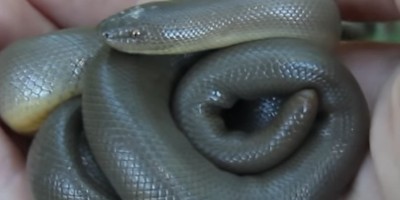 Northern Rubber Boa:
These small constrictors are about one to three feet in length and vary in color from light brown to black. Nocturnal by nature, they mostly eat small mammals, birds, and reptiles, including other snakes. They can burrow, climb, and swim, hence the wide range of their habitat and variety in diet. These snakes have been known to remain active when it’s too cold for other reptiles, and in the wild, they can live up to fifty years. Though found across a wide range of habitats, they tend to prefer meadows, woodlands, and areas alongside streams. Though a constrictor, they’re small enough that they do not pose a threat to people and best left to themselves to live their lives, which as noted previously can be quite long.
Northern Rubber Boa:
These small constrictors are about one to three feet in length and vary in color from light brown to black. Nocturnal by nature, they mostly eat small mammals, birds, and reptiles, including other snakes. They can burrow, climb, and swim, hence the wide range of their habitat and variety in diet. These snakes have been known to remain active when it’s too cold for other reptiles, and in the wild, they can live up to fifty years. Though found across a wide range of habitats, they tend to prefer meadows, woodlands, and areas alongside streams. Though a constrictor, they’re small enough that they do not pose a threat to people and best left to themselves to live their lives, which as noted previously can be quite long.
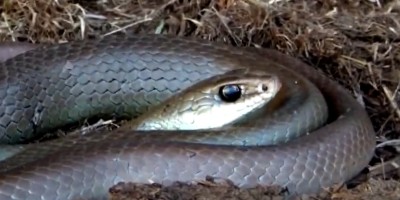 Western Yellow Back Racer:
These non-venomous snakes tend to be under three feet in length within California, though they can get larger in other regions. The adults are brown, blue-grey, or olive with a white or yellow belly. The juveniles are much more brightly colored, so much so that they were thought to be a different species at first. A day snake by nature, they stick to the ground but are able climbers if needed. They tend to eat pretty much anything they can swallow, even members of their own species. As they are not a constrictor, they tend to just grab their prey and either crush it or eat it while the food is still alive. Fond of moist, forested areas, their range spreads along the east coast, where rain and forests aplenty can provide the sort of habitat they find ideal.
Western Yellow Back Racer:
These non-venomous snakes tend to be under three feet in length within California, though they can get larger in other regions. The adults are brown, blue-grey, or olive with a white or yellow belly. The juveniles are much more brightly colored, so much so that they were thought to be a different species at first. A day snake by nature, they stick to the ground but are able climbers if needed. They tend to eat pretty much anything they can swallow, even members of their own species. As they are not a constrictor, they tend to just grab their prey and either crush it or eat it while the food is still alive. Fond of moist, forested areas, their range spreads along the east coast, where rain and forests aplenty can provide the sort of habitat they find ideal.
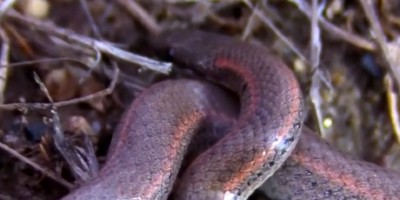 Common Sharp-Tailed Snake:
So named for their pointed tails, obviously, these snakes are generally gray or brown, with rusty red undertones. Often under a foot in length, they mostly feed on slugs, salamanders, and their eggs. Most often active during the day, they prefer to stay buried under debris, such as rocks, logs, and fallen leaves. Fond of the rainier months due to their diet, they tend to live in damper, more forested regions.
Common Sharp-Tailed Snake:
So named for their pointed tails, obviously, these snakes are generally gray or brown, with rusty red undertones. Often under a foot in length, they mostly feed on slugs, salamanders, and their eggs. Most often active during the day, they prefer to stay buried under debris, such as rocks, logs, and fallen leaves. Fond of the rainier months due to their diet, they tend to live in damper, more forested regions.
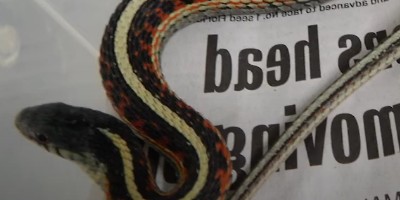 Coast Garter Snake:
Garter snakes are incredibly common across the United States, and several species and subspecies call California home. Coast garter snakes are one such species found in the Salinas area. Usually around a couple of feet in length, their stripes, a hallmark of garters, is highly variable. These snakes stay on the ground and are active during the day. Their diet consists largely of amphibians, slugs, leeches, snails, worms, small mammals, reptiles, and even fish. They prefer to live near water and are adept swimmers. Though not venomous, they do have toxic saliva to help incapacitate prey. Said toxin is harmless to people.
Coast Garter Snake:
Garter snakes are incredibly common across the United States, and several species and subspecies call California home. Coast garter snakes are one such species found in the Salinas area. Usually around a couple of feet in length, their stripes, a hallmark of garters, is highly variable. These snakes stay on the ground and are active during the day. Their diet consists largely of amphibians, slugs, leeches, snails, worms, small mammals, reptiles, and even fish. They prefer to live near water and are adept swimmers. Though not venomous, they do have toxic saliva to help incapacitate prey. Said toxin is harmless to people.
Venomous Snake Species in Salinas
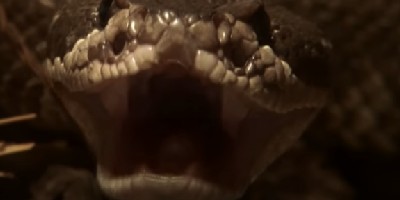 North Pacific Rattlesnake:
These highly venomous pit vipers are between one and three feet in length and can be found across northern and central California. One of several species of rattlers roaming across the state, their color can vary based on habitat, but shades of brown, grey, and tan are common, along with a dark, blotched pattern. The term pit viper stems from the two heat-sensing pits on their faces. If temperature permits, they will be active during the day, but in hotter weather, they will move about at night.
As a larger venomous snake, they eat pretty much whatever they can swallow. Small mammals are common prey, however, due to their warm-blooded nature making them easier to sense. Rattlers also eat other reptiles and birds as well. A notable exception to this is California ground squirrels, as they are immune to rattlesnake venom and tend to get cranky when the snakes try to eat them.
North Pacific Rattlesnake:
These highly venomous pit vipers are between one and three feet in length and can be found across northern and central California. One of several species of rattlers roaming across the state, their color can vary based on habitat, but shades of brown, grey, and tan are common, along with a dark, blotched pattern. The term pit viper stems from the two heat-sensing pits on their faces. If temperature permits, they will be active during the day, but in hotter weather, they will move about at night.
As a larger venomous snake, they eat pretty much whatever they can swallow. Small mammals are common prey, however, due to their warm-blooded nature making them easier to sense. Rattlers also eat other reptiles and birds as well. A notable exception to this is California ground squirrels, as they are immune to rattlesnake venom and tend to get cranky when the snakes try to eat them.
If you're unsure, you can email me a photo of the snake at info@salinassnakes.com and I will email you back with the snake's species. If you found a snake skin, read my Found a Skin? page, and you can email me a photo of the skin, and I'll identify the snake for you. If you need professional Salinas snake removal help, click my Get Help page, or see the below website sponsor I found, who provides that service.
Remember, the term is not poisonous snakes of Salinas, it's venomous snakes of Salinas. Poison is generally something you eat, and venom is injected into you. That said, dangerous snakes are very rare in Salinas. The few venomous snakes of Monterey County are rarely seen. But they are commonly misidentified, so learn about all the snake species of Salinas in order to correctly identify them. These snakes are usually also found in the surrounding towns of Carmel-by-the-Sea, Seaside, Pacific Grove, Marina>, King City, Carmel Valley, Soledad, Moss Landing, Castroville, Greenfield, Prunedale, Sand City, Del Rey Oaks, Gonzales, Chualar, Spreckels, Pajaro, Del Monte Forest, Elkhorn, San Ardo, Lockwood, Las Lomas, San Lucas, Bradley, Boronda, Pine Canyon, and the surrounding areas.
Read our article about:
Do snakes dig holes?
salinassnakes.com domain and hosting costs made possible by the generous support of this sponsor:
